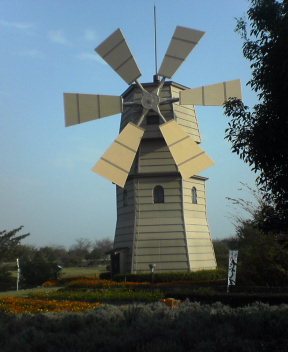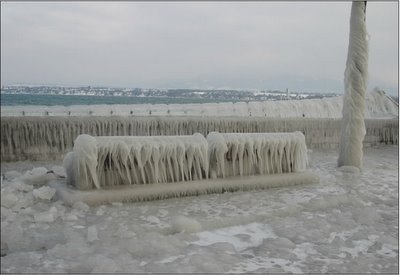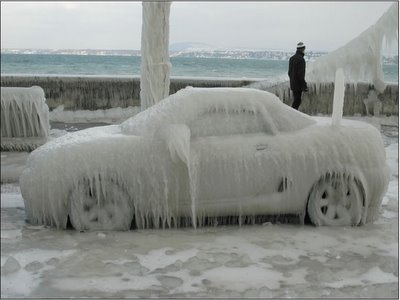
So it's a question long overdue in the asking: Will President-elect Obama be able to enact his ambitious plans for energy independence in the midst of a financial meltdown?
We here at The Thin Green Line polled our extensive staff -- including field researchers, laboratory assistants and policy wonks -- and concluded the answer to that question will depend as much on the man as the circumstances.
But since the man is not even in office yet, and because we won't fully know what kind of president he is until he is president, over-stuffed with turkey as we are, we have decided to confine our effort today to examining the circumstances.
This in and of itself is no small task as, like the issues, they are complex.
It was going to be hard enough to wean Americans off the easy and familiar energy sources of oil and coal in the best of circumstances.
Add to that the tension, fear and volatility of a collapsing economy and "hard" just went to "harder."
How to you jumpstart a new energy matrix when the financial resources required just got flushed down the proverbial de-regulation toilet?
Oddly, it seems, this question makes stark the observation that the world is full of basically two kinds of people, optimists and pessimists or, in this case, entrepreneurs and bean counters.
The bean counter argument is not hard to imagine and has many good points to its credit, not the least of which is "is now the time to invest what little money is available for lending in an untested industry?"
This is being seen already as it relates to wind power, hence our symbolic windmill photo at the top of the page.
Initially, the fastest growing of the major green energy initiatives -- the others being solar, ethanol and, to a lesser extent, geo-thermal -- wind power is now suffering from the collapse of its financial backers, like Lehman Brothers.
"Financing for wind projects is likely to shift more to deep-pocketed utilities and other companies far from Wall Street – including big foreign companies searching for a foothold in the United States," the now solely on-line newspaper reported. "Until this fall, plowing billions into new wind farms from North Dakota to Texas to California had been the epitome of renewable-energy investing for hedge funds and big banks."
Once, the second-fastest growing source of electricity generation after natural gas, wind has hit the perfect storm: Falling fossil fuel prices, especially in natural gas, rising steel prices and a paucity of investors.
And there is another, more integral matter with which green energy must contend in the electrical arena -- the infrastructure itself.
It's not enough to just build graceful wind farms across the plains and stand back to admire our tardy-but-necessary initiative.
The power grid that must carry those busy electrons from the plains to the cities is already seriously over-taxed and not designed for the task at hand.
A recent report by the North American Electric Reliability Corporation notes that switching over to more wind and solar power plants without upgrading the transmission capacity would result in more blackouts and less reliability -- not the kind of thing on which a thriving, high-tech economy is built.
"The report calls for construction of new power lines, which has become more difficult in some regions because of the diminished clout of utilities and the growing strength of preservationists trying to protect rural areas. "
Just such an effort is underway here in eastern Pennsylvania and is meeting with stiff resistance.
Even potential measures to ease this pressure, like voluntary shut-downs in exchange for price breaks, will not be enough to alleviate the shortage of transmission capacity however.
All of which brings us to the optimists or, as we fashioned them earlier, the entrepreneurs.
Some of the nation's most successful entrepreneurs succeed by seeing opportunity in difficulty, solving new problems in new ways.
Not being entrepreneurs here at The Thin Green Line (where wage slavery crushes our inner creative capitalist on a daily basis) we cannot propose those solutions, only have faith that they exist and that those so inclined will be able to find them.
One way to encourage them, argue some, is for a President Obama to enact a "Green New Deal" and use what financial fortitude the U.S. Government has left to support those efforts.
"Such a Green New Deal, woven into the economic stimulus package being crafted for early next year, could create millions of government-subsidized jobs and build a new energy infrastructure,"
The Boston Globe reported in this Nov. 24 article.
"It's a smart thing to do for the economy and a strategically wonderful thing to do for the environment," said David Foster, executive director of the Blue Green Alliance, a partnership between the Sierra Club and United Steelworkers that works to develop green jobs. His group points to a University of Massachusetts report earlier this fall that said a $100 billion investment in clean technology could create 2 million new jobs in the next two years. "It leads us down the path for energy independence. It's a historic opportunity," he told the newspaper.
Supporters of Obama's $150 billion energy plans, including the Union of Concerned Scientists and the Natural Resources Defense Council, say such a plan could include federal financial incentives to quickly build large-scale solar, wind, and other renewable projects. It could also include massive investment in new transmission lines to bring renewable power from rural areas into cities, creating a new electricity grid, according to the Globe.
But it won't be easy. Any reduction in carbon emissions from coal-fired plants are likely to raise electricity prices at a time when deregulation is already set to do that, at least in Pennsylvania, just when most consumers can't afford it. That will make it politically unpopular, requiring an effort to educate the country on why its necessary.
“In times of economic stress, the last thing you want to do is increase peoples’ energy costs with something like cap-and-trade,” Anne Korin, cofounder of the Set America Free Coalition (SAFC) of energy-security hawks and environmentalists, told
The Christian Science Monitor in this Nov. 12 article which examines Obama's plans in some detail.
"SAFC calls for policies that would disconnect the US from imported oil. 'There’s a lot of talk about that, but a congressman who wants to be reelected would be very wary of that,' Ms. Korin says."
If you ask him if he can do it, Obama would likely say it is not him, but all of us that must accomplish this. "Yes WE can" was the mantra of his campaign.
But with the campaign over and his presidency looming, he must also recognize that while we may indeed be able to do it, we won't be able to do it without him.
Labels: Barack Obama, Boston Globe, Christian Science Monitor, Natural Resources Defense Council, New York Times, Union of Conerned Scientists, wind power

 RSS
RSS



